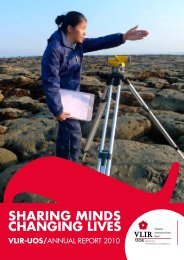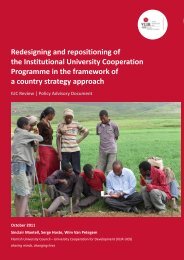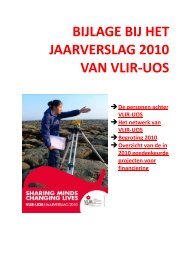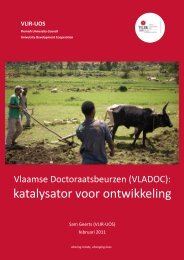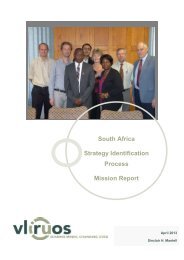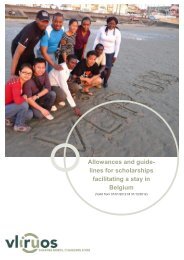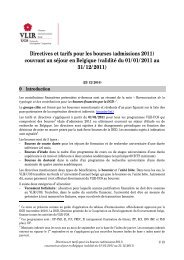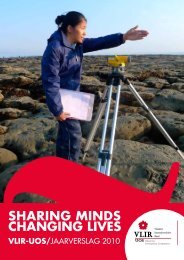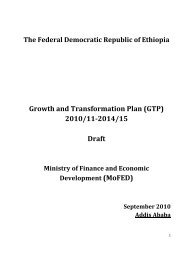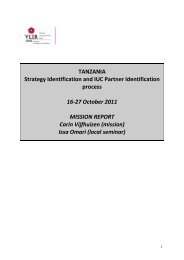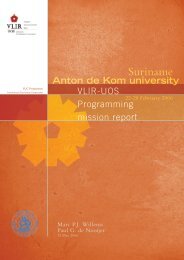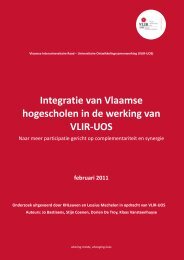Education Sector Development Program - VLIR-UOS
Education Sector Development Program - VLIR-UOS
Education Sector Development Program - VLIR-UOS
Create successful ePaper yourself
Turn your PDF publications into a flip-book with our unique Google optimized e-Paper software.
<strong>Education</strong> <strong>Sector</strong> <strong>Development</strong> <strong>Program</strong> IV<br />
❚<br />
Targets<br />
Gender mainstreaming sustained in<br />
the next curriculum revision<br />
The revised curriculum will be implemented<br />
Activity books for all subjects of all grade levels<br />
will be prepared<br />
All schools and ABE centers will have one set of<br />
syllabi in core subjects for all grade levels<br />
Each primary and secondary school student will<br />
have one full set of textbooks<br />
Examinations will be revised in line with<br />
curriculum<br />
Curriculum implementation assessment<br />
manuals for each subject matter of all grade<br />
levels will be developed<br />
Need assessment for the revision of the next five<br />
year curriculum will be undertaken<br />
Gender mainstreaming will be strengthened in<br />
curriculum revisions at all levels<br />
More effective planning and resource use<br />
by schools<br />
Outcomes:<br />
❚<br />
❚<br />
Targets<br />
The number of schools, who prepare<br />
a relevant SIP in collaboration with<br />
communities, increased<br />
Learning environment made more<br />
conducive, through provision of<br />
sufficient operational funds to schools<br />
and enhanced resource utilization<br />
decisions by school and community<br />
All schools and ABE centers will have completed<br />
a School Improvement Plan approved by PSTAs<br />
and School Boards<br />
All schools and ABE centers will use school<br />
grants to address priority areas identified in the<br />
SIP<br />
Information Communications Technology<br />
Outcomes:<br />
❚<br />
❚<br />
❚<br />
Quality of education improved<br />
through the implementation of all ICT<br />
components in secondary schools<br />
Foundation for e-learning and broader<br />
e-culture strengthened through better<br />
connectivity of educational institutions<br />
to the global information sources.<br />
Digitized Satellite TV – <strong>Program</strong>s<br />
disseminated online by DVD and CD<br />
Targets<br />
% of secondary school teachers who are<br />
computer literate will increase by 100%<br />
% of secondary school teachers who utilize the<br />
satellite TV programs will increase to 100%<br />
% of secondary schools with internet connection<br />
will increase to 100%<br />
% of secondary students who can utilize satellite<br />
TV programs will increase to 100%<br />
% of secondary schools with complete<br />
broadcasting facilities will increase to 100%<br />
Quality of school infrastructure and<br />
facilities<br />
Outcomes:<br />
❚<br />
❚<br />
Quality of school buildings, especially<br />
in remote rural regions, improved<br />
School environment made more<br />
conducive through improvement in<br />
school facilities<br />
Indicators and targets<br />
% of schools with standard facilities will increase<br />
by 100%<br />
Each school will establish/strengthen provision<br />
of separate latrines for both sexes<br />
3. Policy and strategies<br />
During the implementation of ESDP IV, quality<br />
improvement strategies will address several<br />
complementary challenges. Firstly, a significant<br />
number of schools, teachers and students,<br />
especially in the more remote rural regions,<br />
do not yet have the basic inputs for the delivery<br />
of quality education to be possible. Therefore,<br />
some strategies aim at ensuring that these basic<br />
inputs (such as curricula, textbooks, teacher<br />
guides and some facilities) are available in all<br />
schools. Secondly, the quality of teaching in the<br />
classroom needs further improvement. To allow<br />
this to happen, more systematic attention is given<br />
to teacher professional development through<br />
strengthening pre-service and in-service training<br />
and improving teacher supervision and support.<br />
At the same time, the curriculum is being revised<br />
and textbooks and examinations will undergo a<br />
similar revision. Thirdly, quality improvement<br />
depends strongly on the actions which the school<br />
staff and the surrounding community undertake.<br />
School staff will therefore be given the necessary<br />
tools (such as guidelines on School Improvement<br />
Plans), the necessary resources (through a school<br />
grant system) and relevant training to help them<br />
23



